Growing an herb garden indoors is a rewarding and practical way to have fresh flavors at your fingertips. Whether you’re limited on outdoor space or want to bring a touch of green inside, starting a small herb garden inside your home is easier than you might think. This guide walks you through everything you need to know to grow herbs successfully indoors, from choosing the right plants to caring for them.
Why Grow Herbs Indoors?
Indoor herb gardening offers many benefits:
– Year-round access to fresh herbs regardless of weather
– Convenience, as herbs are close to your kitchen for cooking
– Improved air quality and natural fragrance indoors
– A rewarding hobby that brightens your living space
If you’ve considered growing herbs but aren’t sure where to start, read on for practical tips and advice.
Choosing the Best Herbs for Indoor Gardening
Not all herbs thrive indoors equally. Some are well-suited for container growth and limited light, making them ideal beginners’ herbs.
Top Indoor Herbs for Beginners
– Basil: Requires bright light, grows quickly, great for Italian dishes
– Mint: Hardy and spreads easily; best grown in its own pot
– Parsley: Prefers moderate light and consistent moisture
– Chives: Easy to grow with moderate light; adds onion flavor
– Thyme: Needs bright light and well-drained soil
– Oregano: Thrives in bright light, drought-tolerant once established
Tip: Start with 2-3 herbs you use most often to keep things manageable.
Selecting Containers and Soil
Containers
Choose pots with good drainage holes to prevent waterlogging. Containers can be traditional clay pots, plastic pots, or even recycled containers—just make sure they have drainage.
Size matters: Herbs prefer smaller pots that restrict root growth slightly, which promotes better flavor and prevents overcrowding.
Soil
Use a high-quality potting mix formulated for indoor plants or herbs. Avoid garden soil, as it may contain pests and drain poorly.
For best results:
– Well-draining potting soil
– Lightweight with added perlite or vermiculite for aeration
– Slightly acidic to neutral pH (6.0-7.0)
Choosing the Right Location and Lighting
Light is the most critical factor for indoor herb growth.
Ideal Lighting
– Most herbs prefer 6-8 hours of bright, indirect sunlight daily.
– A south or west-facing window is usually best.
– If natural light is limited, use a grow light designed for plants.
Tips for Placement
– Rotate pots regularly for even light exposure.
– Avoid drafts and extreme temperature fluctuations.
– Keep herbs away from heating vents or air conditioners.
Planting Your Indoor Herbs
Starting from Seeds or Seedlings
– Seeds are economical and fun to start but require more time and patience.
– Seedlings (young plants) from nurseries offer a quicker start.
If starting from seed:
– Follow seed packet instructions for depth and spacing.
– Keep soil moist but not soggy.
– Use a seed tray or small pots before transplanting.
Potting the Plants
– Fill your pot with potting mix, leaving about one inch below the rim.
– Remove plants gently from their nursery containers.
– Loosen root balls slightly if roots are tightly bound.
– Place the plant and fill soil around the roots with light pressure.
– Water well to settle the soil.
Caring for Your Indoor Herb Garden
Watering
– Herbs prefer moist but not soggy soil.
– Water when the top inch of soil feels dry.
– Ensure excess water drains to avoid root rot.
– Reduce watering in cooler months.
Feeding
– Use a balanced, water-soluble fertilizer every 4-6 weeks during active growth.
– Avoid over-fertilizing, which can reduce flavor intensity.
Pruning and Harvesting
– Regular trimming encourages bushier growth.
– Harvest leaves from the top and outer parts of the plant.
– Avoid removing more than one-third of the plant at a time.
– Use fresh herbs right away or dry/freeze for later use.
Pest Management
– Common pests include aphids, spider mites, and whiteflies.
– Inspect plants regularly.
– Wipe leaves with a damp cloth or use insecticidal soap if needed.
Troubleshooting Common Issues
– Leggy plants: Caused by insufficient light—move to brighter location or add grow lights.
– Yellow leaves: Often due to overwatering or poor drainage.
– Slow growth: Could indicate lack of nutrients or insufficient light.
– Wilting: Check watering routines; underwatering or overwatering can cause wilting.
Final Tips for Success
– Start small; you can expand your herb garden as you gain confidence.
– Keep a small notebook to track watering, fertilizing, and plant health.
– Experiment with different herbs to discover your favorites.
– Enjoy the sensory benefits of fresh herbs—visual beauty, aroma, and taste!
Growing a small indoor herb garden is a simple way to enhance your home cooking and add natural greenery to your space. With the right care and attention, your herbs will thrive and provide delicious, fresh aromas throughout the year. Happy gardening!

